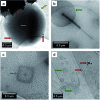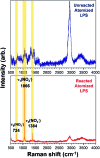Atmospheric chemistry of bioaerosols: heterogeneous and multiphase reactions with atmospheric oxidants and other trace gases
- PMID: 28567251
- PMCID: PMC5450524
- DOI: 10.1039/c6sc02353c
Atmospheric chemistry of bioaerosols: heterogeneous and multiphase reactions with atmospheric oxidants and other trace gases
Abstract
Advances in analytical techniques and instrumentation have now established methods for detecting, quantifying, and identifying the chemical and microbial constituents of particulate matter in the atmosphere. For example, recent cryo-TEM studies of sea spray have identified whole bacteria and viruses ejected from ocean seawater into air. A focal point of this perspective is directed towards the reactivity of aerosol particles of biological origin with oxidants (OH, NO3, and O3) present in the atmosphere. Complementary information on the reactivity of aerosol particles is obtained from field investigations and laboratory studies. Laboratory studies of different types of biologically-derived particles offer important information related to their impacts on the local and global environment. These studies can also unravel a range of different chemistries and reactivity afforded by the complexity and diversity of the chemical make-up of these particles. Laboratory experiments as the ones reviewed herein can elucidate the chemistry of biological aerosols.
Figures










Similar articles
-
CAICE Studies: Insights from a Decade of Ocean-Atmosphere Experiments in the Laboratory.Acc Chem Res. 2020 Nov 17;53(11):2510-2520. doi: 10.1021/acs.accounts.0c00504. Epub 2020 Oct 22. Acc Chem Res. 2020. PMID: 33086794
-
Reactive VOC Production from Photochemical and Heterogeneous Reactions Occurring at the Air-Ocean Interface.Acc Chem Res. 2020 May 19;53(5):1014-1023. doi: 10.1021/acs.accounts.0c00095. Epub 2020 May 5. Acc Chem Res. 2020. PMID: 32369349
-
New Multiphase Chemical Processes Influencing Atmospheric Aerosols, Air Quality, and Climate in the Anthropocene.Acc Chem Res. 2020 Oct 20;53(10):2034-2043. doi: 10.1021/acs.accounts.0c00246. Epub 2020 Sep 14. Acc Chem Res. 2020. PMID: 32927946 Free PMC article.
-
Iron content in aerosol particles and its impact on atmospheric chemistry.Chem Commun (Camb). 2024 Feb 13;60(14):1840-1855. doi: 10.1039/d3cc04614a. Chem Commun (Camb). 2024. PMID: 38268472 Review.
-
10th Anniversary review: applications of analytical techniques in laboratory studies of the chemical and climatic impacts of mineral dust aerosol in the Earth's atmosphere.J Environ Monit. 2008 Aug;10(8):919-34. doi: 10.1039/b805153d. Epub 2008 Jul 11. J Environ Monit. 2008. PMID: 18688461 Review.
Cited by
-
The composition of the bacterial communities collected from the PM10 samples inside the Seoul subway and railway station.Sci Rep. 2024 Mar 18;14(1):6478. doi: 10.1038/s41598-023-49848-x. Sci Rep. 2024. PMID: 38499557 Free PMC article.
-
The source and transport of bioaerosols in the air: A review.Front Environ Sci Eng. 2021;15(3):44. doi: 10.1007/s11783-020-1336-8. Epub 2020 Dec 17. Front Environ Sci Eng. 2021. PMID: 33589868 Free PMC article. Review.
-
Interfacial Enrichment of Lauric Acid Assisted by Long-Chain Fatty Acids, Acidity and Salinity at Sea Spray Aerosol Surfaces.J Phys Chem A. 2024 Aug 29;128(34):7195-7207. doi: 10.1021/acs.jpca.4c03335. Epub 2024 Aug 6. J Phys Chem A. 2024. PMID: 39106367 Free PMC article.
-
Heterogeneous nitration reaction of BSA protein with urban air: improvements in experimental methodology.Anal Bioanal Chem. 2022 Jun;414(15):4347-4358. doi: 10.1007/s00216-021-03820-8. Epub 2022 Jan 11. Anal Bioanal Chem. 2022. PMID: 35013806
-
Cholesterol provides nonsacrificial protection of membrane lipids from chemical damage at air-water interface.Proc Natl Acad Sci U S A. 2018 Mar 27;115(13):3255-3260. doi: 10.1073/pnas.1722323115. Epub 2018 Mar 5. Proc Natl Acad Sci U S A. 2018. PMID: 29507237 Free PMC article.
References
-
- Pöschl U. Angew. Chem., Int. Ed. 2005;44:7520–7540. - PubMed
-
- Pósfai M., Buseck P. R. Annu. Rev. Earth Planet. Sci. 2010;38:17–43.
-
- Ramanathan V., Crutzen P. J., Kiehl J. T., Rosenfeld D. Science. 2001;294:2119–2124. - PubMed
-
- Lohmann U., Feichter J. Atmos. Chem. Phys. 2005;5:715–737.
-
- Mahowald N., Ward D. S., Kloster S., Flanner M. G., Heald C. L., Heavens N. G., Hess P. G., Lamarque J.-F., Chuang P. Y. Annu. Rev. Environ. Resour. 2011;36:45–74.
Publication types
LinkOut - more resources
Full Text Sources
Other Literature Sources

